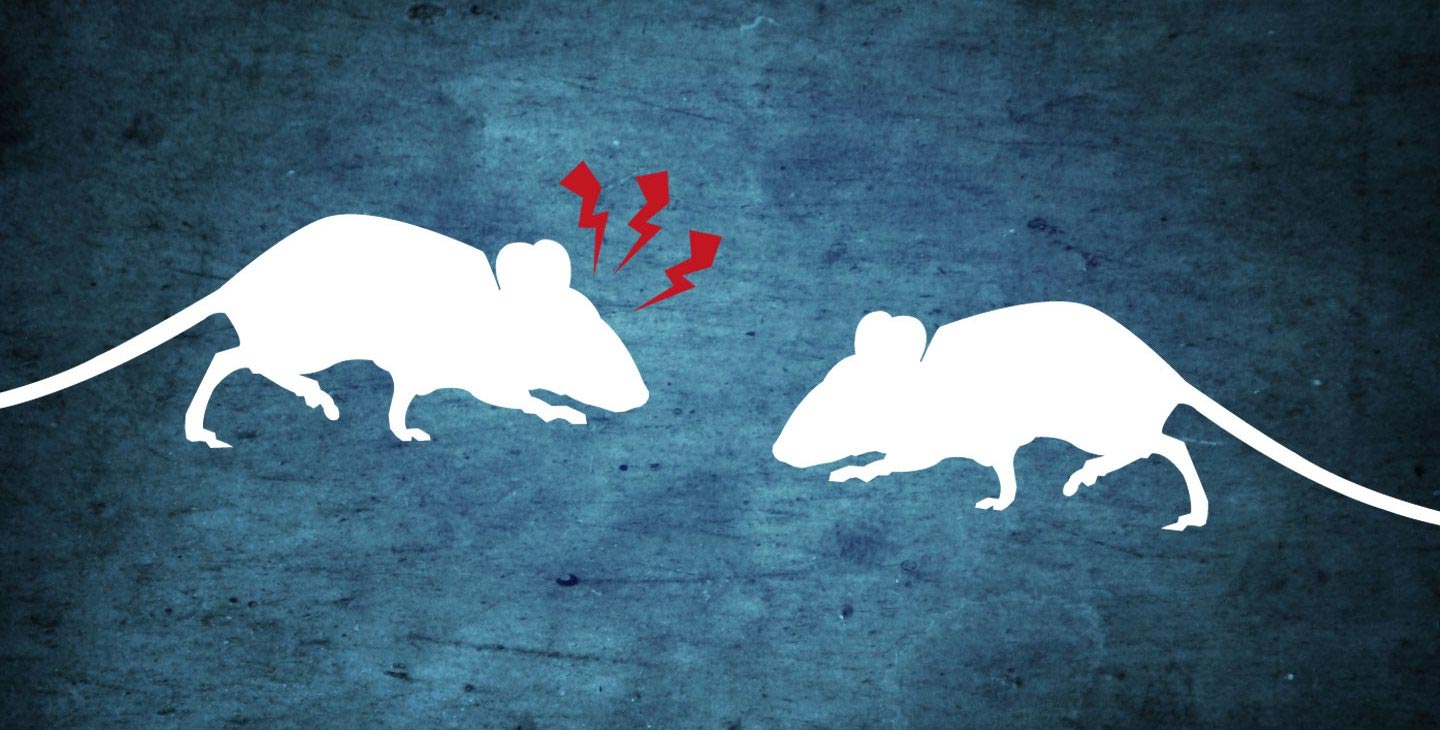Caltech researchers have found that hard-wired neural circuits that control aggression in mice are amplified after their victories in aggressive encounters. Image credit: Caltech
Like a champion fighter who gains confidence after every win, a male mouse that prevails over other male mice in several consecutive aggressive encounters will become even more aggressive in future encounters, attacking faster and longer, and ignoring his opponent’s submission signals.
This phenomenon is of interest to people studying the neurosciences of behavior because aggression is an innate, hard-wired behavior in the brain. This means that a mouse doesn’t have to learn aggressive behaviors before engaging in them. Aggression is instinctive by the time you reach adulthood. However, experiences (e.g. repeated successful aggressive encounters) can change this innate behavior.
Now a team of Caltech researchers have found that hard-wired neural circuits that control aggression in mice are amplified after their victories in aggressive encounters, and have identified a learning mechanism that works in the hypothalamus – a region of the brain traditionally used as a source of Instincts. instead of learning.
The research was conducted in the laboratory of David Anderson, Seymour Benzer Professor of Biology, Chair of the Tianqiao and Chrissy Chen Institute of Neuroscience, Howard Hughes Medical Institute Investigator, and Director of the Tianqiao and Chrissy Chen Institute of Neuroscience at Caltech.
An article describing the research appears in the journal Procedure of the National Academy of Sciences on September 24, 2020.
There is a difference between innate and learned behaviors. For example, mice can be taught that performing certain behaviors (e.g., pulling a lever) can lead to a positive outcome (e.g., receiving food). On the other hand, innate behaviors such as aggression are instinctive for male mice; The mice do not need to learn how to fall and attack when confronted with other mice they consider a threat – they just react.
Previous studies have shown that once a male mouse has won multiple aggressive encounters with other men, it will show increased aggression in future encounters. In other words, an innate behavior is changed by experience. This effect is known as “aggression training”.
Led by postdoctoral fellow Stefanos Stagkourakis, the Caltech team investigated a specific link in the mouse brain in which a group of synapses signals signals from a poorly studied region at the junction between the amygdala (a brain region known for its role in fear-related behavior is) transmits) and the hippocampus (which plays a role in short-term memory) to a specific subdivision of the hypothalamus, the ventromedial hypothalamus (VMH), which controls aggressive behavior in mice. (The hypothalamus also contains neurons in other subdivisions that mediate other social and homeostatic behaviors, such as mating, parental behavior, feeding, and thermoregulation, but these have not been studied.)
The team found that after aggression training, these synapses show signs of long term potentiation (LTP), similar to turning the volume knob on the signal. Instead of just talking to the neurons in the hypothalamus, these synapses yell at them, making them react more strongly.
Using the Caltech Brain Imaging Center, the team examined the dendrites of neurons, protrusions of neurons that receive signals from other neurons, and specifically the spines of the dendrites, structures that act like miniature radio antennas on the hypothalamic neurons to receive input from others capture brain regions. They examined the number, size, and shape of these structures before and after aggression training. They found that aggression training caused many additional dendritic spines to grow on hypothalamic neurons. It is expected that such structural changes will make these neurons more sensitive to incoming signals and therefore more easily activated.
The team also experimentally prevented the formation of LTP on these synapses during aggression training and found that aggression training no longer resulted in an increase in aggressive behavior in these mice.
Although all male mice tested were genetically identical, about 25 percent never showed aggression and were also “immune” to behavioral changes caused by aggression training. The authors also found that such behavioral heterogeneity in genetically identical mice is due to naturally occurring fluctuations in serum testosterone levels: the non-aggressive mice had, on average, lower testosterone levels than their aggressive siblings. Administration of additional testosterone to the non-aggressive mice caused both aggressive behavior and LTP to occur at the amygdala-hypothalamic synapses.
This work identifies changes in a very specific region of the brain after aggression training, but the adaptations that mediate the behavioral effect of aggression training are likely to occur in multiple locations in the brain. In future work, the team will examine how neural activity changes in different areas of the brain after social experience, and try to identify brain nodes of high importance in the neural aggression circuit. The team also hopes to study how testosterone levels can vary in otherwise genetically identical mice, since the hormone is synthesized by genetically encoded enzymes.
Reference: “Experience-dependent plasticity in innate social behavior is mediated by hypothalamic LTP” by Stefanos Stagkourakis, Giada Spigolon, Grace Liu and David J. Anderson, September 24, 2020, Procedure of the National Academy of Sciences.
DOI: 10.1073 / pnas.2011782117
CaltechAUTHORS: 20200723-122438626
The paper is entitled “Experience-dependent plasticity in innate social behavior is mediated by hypothalamic LTP.” Stagkourakis is the newspaper’s lead author. Other co-authors include microscopy technician Giada Spigolon, student Grace Liu, and Anderson. Funding came from the National Institutes of Health, EMBO and the Howard Hughes Medical Institute.



